Last Updated on October 27, 2022
Estimated reading time: 9 minutes
Updated for 2022 – 2023
By Jim Ferri
The Boston Freedom Trail – experienced either self-guided or with a guide – is one of the most popular walks in America. What makes it so interesting is that on the tour you’re both seeing the beauty of the city while having the early history of America come alive.
With a few hours to spare one morning, I decided to walk the trail. My self-guided tour of the Boston Freedom Trail took me 2.5-miles past 16 historic sites, each significant in early American history. Admission to each of the sites is free, unless noted otherwise.
On your walk along the Freedom Trail you’re guided from site to site by a line of red bricks set in the sidewalk. Some areas along the trail are badly in need of repair, however. A couple of times I lost track where bricks were missing on a torn-up sidewalk.
Park Church
To begin my self-guided tour of the Boston Freedom Trail, I left the subway at Park Street, right at Boston Common. Across the street was Park Street Church, one of the gathering places of colonial patriots prior to the war of independence from Britain. I crossed the street and entered the Church. There I walked up the stairs and passed through leather-covered doors into the spacious sanctuary. Long pews and balconies there ran across the back and down the sides.
Eavesdropping on a docent speaking with some other visitors, I realized the church wasn’t from colonial times as I thought. It was, however, built in the early 1800s on the site of an old granary. In fact, the old granary was where colonists made the sails for the USS Constitution, “Old Ironsides.”
This Boston church, however, is historical in its own right. It became famous for supporting Abolitionist causes long before the Civil War. It’s a beautiful church with clear windows. They’re clear, according to the docent, so one can see the Commons on one side, and the Granary Burial Ground on the opposite.
Graves of John Hancock and Paul Revere
I left the church and continued my self-guided tour along the Boston Freedom Trail. I walked about a hundred yards more to the adjacent Granary Burial Ground. There I found a mini- “Who’s Who” of colonial America. Nearest the church was the grave of John Hancock.
Graves of some of those who died in the Boston Massacre are also scattered about the cemetery. I discovered Paul Revere’s towards the back. Covering both the marker next to his grave, as well as the actual grave site, were pennies and small rocks people had placed there.
It was a very peaceful and beautiful place despite it being located in a busy part of modern-day Boston. Walking about reading the tombstones made history come alive for me. I could now relate to these patriots as real people, not just some names printed in a school textbook.
A Surprise on the Boston Freedom Trail
The next stop on my self-guided Freedom Trail tour of Boston was the King’s Chapel Burying Ground. And I was amazed to learn it was actually older than the Granary. There are a few notables interred there including Massachusetts’ first Governor, John Winthrop.
But I hadn’t some to see the Governor, but rather the grave of Mary Chilton, the first woman to step off the Mayflower. At first I couldn’t find her tombstone until someone showed me the right direction. I found it almost hidden in the back of the cemetery. More astonishingly, the grave stone was facing in the opposite direction of all the others.
Old South Meetinghouse – An Important Boston Freedom Trail Stop
The Old South Meetinghouse is a national historic site. It’s high on the list of must-see’s on a tour of the Boston Freedom Trail, self-guided or not. When I entered I found a woman explaining the tea tax to a group of grammar school children. The tax incensed the colonists and led to the revolution.
Talking with her later, I found that the South Meeting House is actually overseen by a private nonprofit organization, Revolutionary Spaces. In the actual places where the colonists sat in their meetings, they give presentations to schoolchildren. The children then get to argue the pros and cons of the tax, as if they were colonists.
“It’s not exactly accurate most of the time,” she confided in me. “But the kids really get a sense of the history and the basis for all of the things they’re learning.”
The most interesting exhibit in the place though, was the model of the town of Boston in 1773. Although the kids could care less about the display, it was mesmerizing to most of the adults who were seeing not only how small many of the buildings were at the time of the American Revolution, but also just how small the actual town of Boston was at the time. It is exceptionally well done; you could read a brief description of a person’s home and then press a button to see its location.
A Popular Freedom Trail Stop: Faneuil Hall and Quincy Marketplace
Back out walking along the Boston Freedom Trail I began to realize just how many people were doing the same thing I was, many with maps in hand, several others doing tours by listening to a download on their iPod, or following a map on their iPad. A few times I had to ask one of them for directions.
Later on I came to Faneuil Hall and the frenetic Quincy Market, the latter always crowded regardless of the season and bursting at the seams with innumerable shops and food stalls. Having been there before I did little more than stick my head in for a quick look and continued to follow the trail up into the city’s Italian North End.
The North End
One of the interesting things about a self-guided tour of the Boston Freedom Trail is that you have opportunity to step off it whenever you see something of interest along the way. You can’t do that on a group guided tour.
That’s what happened to me when the Boston Freedom Trail turned down Richmond Street in Boston’s Italian North End and I saw Solamuria Italiana, flaunting itself as Boston’s best Italian grocery. Ducking inside I could see why: the sight inside the little grocery was exceptionally appetizing. And it was full of local old Italians in the area.
Paul Revere’s House
I was tempted to buy a sandwich but didn’t. After a few minutes I instead headed back out the door to search for Paul Revere’s house a few blocks away.
It was disappointing that you aren’t allowed to take photos inside Revere’s house. But it is interesting since you get to see exactly what houses were like in colonial America. Everything inside the house was a period piece, some owned by Revere himself. (Admission is $5.00 per adult, seniors and college students $4.50 and children (ages 5-17) $1.00).
Next stop was the Old North Church, which you access on the Freedom Trail via the Paul Revere Mall across from the church Rose Kennedy used to attend. On the little mall is a statue of Revere on horseback.
You may also enjoy: Civil War (and Other) Reenactments in the U.S. / Visiting America’s Industrial Past / The Maine Coast: A Great Summer Road Trip
The Old North Church on the Freedom Trail
The Old North Church was interesting only in that it gave a sense of how people worshiped at the time. The family pew boxes in the church were surprising, as was the archaeological dig being done at the 1715 Clough House next door. After the church I visited the nearby mildly interesting Copp’s Hill Burying Ground where I only stayed a few minutes.
I had a similar reaction to Bunker Hill before continuing on to the USS Constitution, the final site on my self-guided tour of the Boston Freedom Trail. The walk there seemed much longer than I had anticipated, probably due to the rain that had started to fall as I left Copp’s.
The tour of USS Constitution, known as “Old Ironsides” was quite interesting, as well. But the weather put a damper on it since we weren’t given an on-deck tour, only below deck.
We were shown around the gun deck by a seaman who told us a lot about the history of the ship and what it was like living aboard it. Among the shared minutiae was that although the ship had a crew of almost 500, it carried only two cooks – one for the Captain, the other for the crew.
If you’re in Boston, a self-guided tour of the Freedom Trail is worth a leisurely day or a busy half-day walking tour, especially if you’re an American, since it puts you in touch with our country’s history. Non-Americans will also find it interesting from a cultural and historic perspective.
It’s a long walk, however, and you may want to trim the tour a bit if you’re on foot.
If you go:
The Freedom Trail Foundation
99 Chauncy Street, Suite 401
Boston, MA 02111
Tel: (617) 357-8300
http://www.thefreedomtrail.org/
Greater Boston Convention and Visitors Bureau
2 Copley Place, Suite 105
Boston, MA 02116
Tel: (888) 733-2678
http://www.bostonusa.com/

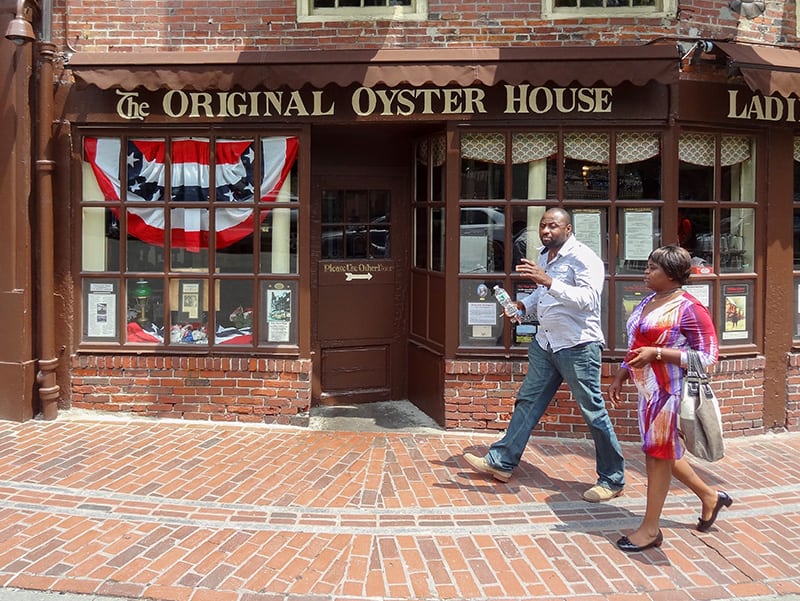
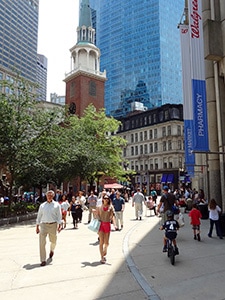
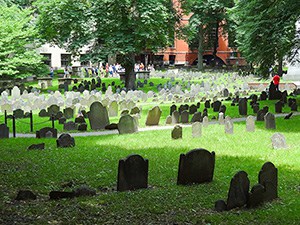
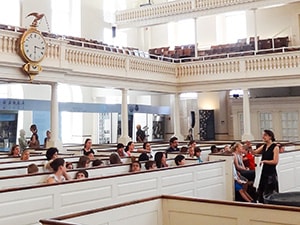
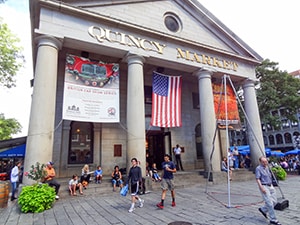
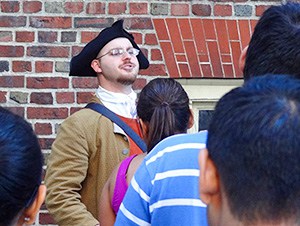
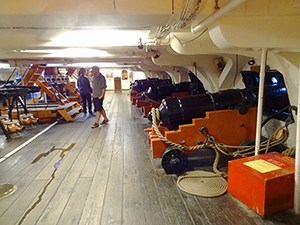
Leave a Reply